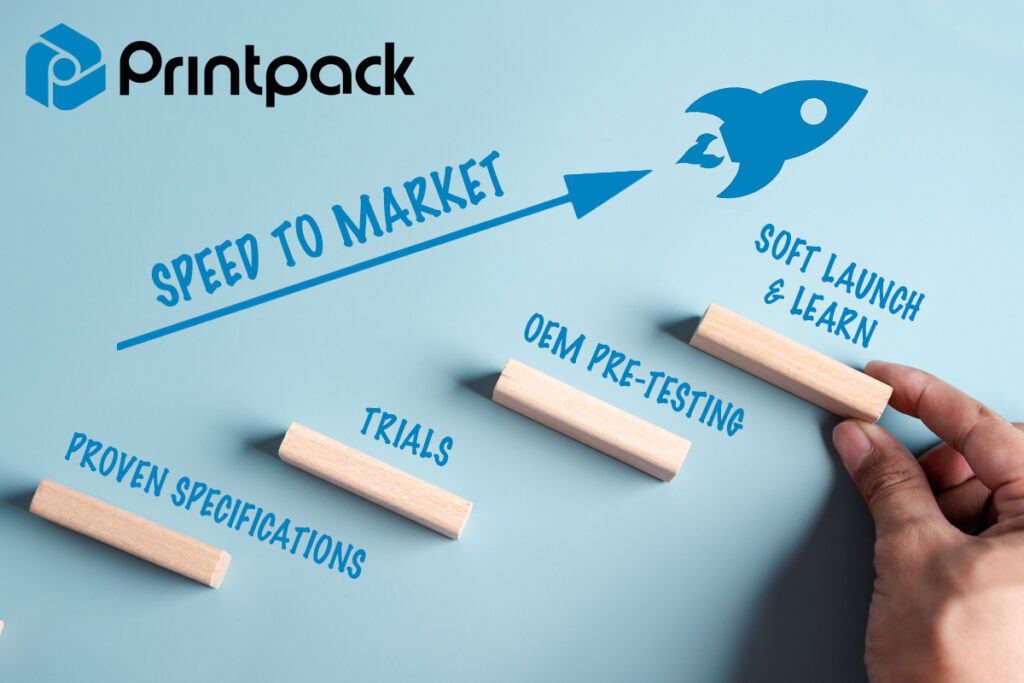Looking to shorten your packaging production process? In the fast-paced world of packaging, speed to market is important for successful launches. Here is what you must consider so that your brand can remain agile and competitive.
Understand the Elements of the Packaging Development Process
The packaging development process involves multiple stages, each crucial for ensuring the final product meets quality, functionality, and aesthetic standards. The core phases are:
- Research: Define requirements and evaluate options for your packaging based on shelf life or product integrity needs, design/brand necessities, consumer preferences, and other factors that pertain to your brand.
- Design Structures: Select the top material options with sustainability in mind, and gather potential samples and prototypes.
- Run Trials: Test prototypes with consumers and analytics labs, to ensure that materials meet performance standards, regulatory requirements, and overall consumer acceptance.
- Analyze Results & Plan Production: Analyze cost-efficiency and timeline estimates for production stages.
Strategies to Move Faster While Mitigating Risk
To stay ahead without compromising quality, it is essential to avoid risks while accelerating the development process.
Leverage Proven Specifications
By using established specifications and collaborating with trusted suppliers, companies can avoid the complexities and risks of creating new solutions from scratch. Although some brands may prefer to dictate the process in a more customized way, relying on the manufacturer’s expertise and proven approaches can streamline development and ensure the reliability of material combinations.
Digital Printing for Trials
Digital printing allows for the rapid production of small quantities with very short lead times, making it an ideal choice for initial testing (phase 1 of production). While not always suitable for large-scale production, digital printing excels when limited rolls are needed quickly for early trials. Conventional flexographic or rotogravure printing can take 8-12 weeks and requires larger minimum quantities, whereas digital printing lead times are just 1-2 weeks. This approach can save up to 10 weeks in the trial phase, significantly streamlining the development process.
Pre-testing at Machinery OEMs
OEM (original equipment manufacturer) machines, which are available for demonstrations in showrooms and labs, can help companies avoid disrupting their own production lines. This is especially beneficial for experimental or sustainable materials, as it allows for thorough testing without the risk of production failures. Although there are some costs associated with pre-testing at OEM sites, this approach prevents much costlier production stoppages and ensures a smoother, lower-stress development process.
“Soft Launch” & “Launch & Learn”
A “Soft Launch” involves implementing packaging changes without making immediate marketing claims, so companies can assess technical performance and manage risks discreetly. This strategy is crucial if a rollback is necessary due to unexpected failures and can help prevent damage to the brand’s reputation.
A “Launch & Learn” strategy allows for a regional test to gather valuable feedback on the packaging’s technical qualities like durability and freshness without widespread consumer impact.Both methods ensure thorough testing and minimize potential risks to the brand before a broader market rollout.
Implementing these insights into your packaging development process can help your business thrive in today’s market. Having the first-mover advantage and meeting consumer demands quickly can set your product apart from competitors – so stay safe and stay speedy!


 July 18, 2024
July 18, 2024 
 Nicole Karamallakis
Nicole Karamallakis 
